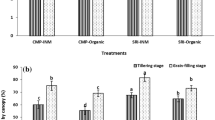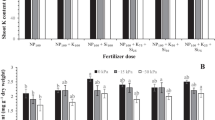Abstract
Background and aims
Rice cultivars bred for fertile soils may not be the best suited to nutrient limited environments. Therefore, rice cultivars suited to sustain productivity in low-fertile soils and their adaptive mechanisms for success need to be identified.
Methods
Field experiments were conducted in fertile and low-fertile sites for two and five seasons, respectively, using forty four widely grown rice cultivars in Sri Lanka. Growth and tissue nitrogen (N), phosphorus (P) and potassium (K) concentrations were measured.
Key results
Plant biomass and shoot- N, P and K contents were reduced by 41, 54, 74 and 36% under low soil fertility, respectively, while crop duration was extended by 12 days. Relationships between grain dry weight (DW- g plant−1) of a cultivar, and seed N, P and K concentrations were negative (P < 0.05) at the fertile site, and this was true only for N at the low-fertile site. Seed- P and K concentrations at the low-fertile site reached to minimum and stable concentrations (1.45 and 1.61 mg g−1, respectively). Irrespective of the soil fertility status, grain DW of rice cultivars was positively correlated with shoot N, P and K contents (mg plant−1) and their accumulation rates (mg plant−1 day−1). Moreover, grain DW of a rice cultivar at the low-fertile site could be explained by shoot P content, seed P concentration and P-harvest index through regression (R2 = 0.74, significant at P < 0.05). Cultivars; Bw451, Bg379–2, H4, At362, Ld408, Bg454, Bw400, At353, Bg380, At402, Bw452, Ld365, and Bw453 had higher grain DW than other cultivars at the low-fertile site.
Conclusion
Rice cultivars with higher capacity to accumulate N, P and K (mg plant−1 day−1), and longer crop duration ensured higher grain DW while seed P and K concentrations are not good indicators to select promising rice cultivars to low-fertile soils with severe P limitation.







Similar content being viewed by others

References
Asai H, Saito K, Samson B, Songyikhangsuthor K, Homma K, Shiraiwa T, Kiyono Y, Inoue Y, Horie T (2009) Yield response of indica and tropical japonica genotypes to soil fertility conditions under rainfed uplands in northern Laos. Field Crop Res 112:141–148
Atlin GN, Lafitte HR, Tao D, Laza M, Amante M, Courtois B (2006) Developing rice cultivars for high-fertility upland systems in the Asian tropics. Field Crop Res 97:43–52
Dobermann A, Fairhurst T (2000) Rice: nutrient disorders and nutrient management, IRRI, Philippines, PPI, USA and PPIC, Canada
Fukai S, Inthapanya P, Blamey FPC, Khunthasuvon S (1999) Genotypic variation in rice grown in low fertile soils and drought-prone, rainfed lowland environments. Field Crop Res 64:121–130
Haefele SM, Wopereis MCS, Ndiaye MK, Barro SE, Ould Isselmou M (2003) Internal nutrient efficiencies, fertilizer recovery rates and indigenous nutrient supply of irrigated lowland rice in Sahelian West Africa. Field Crop Res 80:19–32
Haefele SM, Wopereis MCS, Schloebohm AM, Wiechmann H (2004) Long-term fertility experiments for irrigated rice in the west African Sahel: effect on soil characteristics. Field Crop Res 85:61–77
Haefele SM, Nelson A, Hijmans RJ (2014) Soil quality and constraints in global rice production. Geoderma 235:250–259
Haefele SM, Kato Y, Singh S (2016) Climate ready rice: augmenting drought tolerance with best management practices. Field Crop Res 190:60–69
Horie T, Shiraiwa T, Homma K, Katsura K, Maeda S, Yoshida H (2005) Can yields of lowland rice resume the increases that they showed in the 1980s? Plant Prod Sci 8:259–274
Inthapanya P, Sipaseuth Sihavong P, Sihathep V, Chanphengsay M, Fukai S, Basnayake J (2000) Genotypic performance under fertilised and non-fertilised conditions in rainfed lowland rice. Field Crop Res 65:1–14
Katsura K, Tsujimoto Y, Oda M, Matsushima K-i, Inusah B, Dogbe W, Sakagami J-I (2016) Genotype-by-environment interaction analysis of rice (Oryza spp.) yield in a floodplain ecosystem in West Africa. Eur J Agron 73:152–159
Kekulandara D, Bandaranayake P, Sirisena D, Samarasinghe W, Suriyagoda L (2017) Temporal tillering behavior of Sri Lankan elite rice varieties in response to phosphorus availability. Trop Agric Res 28:133–143
Kitson RE, Mellon MG (1944) Colorimetric determination of phosphorus as molybdivanadophosphoric acid. Ind Eng Chem Anal Ed 16:379–383
Koutroubas SD, Ntanos DA (2003) Genotypic differences for grain yield and nitrogen utilization in Indica and japonica rice under Mediterranean conditions. Field Crop Res 83:251–260
Liu X, Xu S, Zhang J, Ding Y, Li G, Wang S, Liu Z, Tang S, Ding C, Chen L (2016) Effect of continuous reduction of nitrogen application to a rice-wheat rotation system in the middle-lower Yangtze River region (2013–2015). Field Crop Res 196:348–356
Lynch JP (2011) Root phenes for enhanced soil exploration and phosphorus acquisition: tools for future crops. Plant Physiol 156:1041–1049
Mayamulla S, Weerarathne LVY, Marambe B, Sirisena DN, Suriyagoda LDB (2017) Variation in seed nutrient content, seedling growth and yield of rice varieties grown in a paddy field without application of fertilisers for forty years. Crop Pasture Sci 68:337–348
Nelson DW, Sommers L (1980) Total nitrogen analysis of soil and plant tissues. J Assoc Off Anal Chem 63:770–778
Peng S, Bouman BAM (2007) Prospects for genetic improvement to increase lowland rice yields with less water and nitrogen. In: Spiertz JHJ, Struik PC, van Laar HH (eds) Scale and complexity in plant systems research: gene–plant–crop relations. Springer, New York, pp 251–266
Peng S, Cassman KG, Virmani SS, Sheehy J, Khush GS (1999) Yield potential trends of tropical rice since the release of IR8 and the challenge of increasing rice yield potential. Crop Sci 39:1552–1559
Peng S, Huang J, Sheehy JE, Laza RC, Visperas RM, Zhong X, Centeno GS, Khush GS, Cassman KG (2004) Rice yields decline with higher night temperature from global warming. Proc Natl Acad Sci USA 101:9971–9975
Peng S, Buresh RJ, Huang J, Yang J, Zou Y, Zhong X, Wang G, Zhang F (2006) Strategies for overcoming low agronomic nitrogen use efficiency in irrigated rice systems in China. Field Crop Res 96:37–47
Poussin JC, Wopereis MCS, Debouzie D, Maeght JL (2003) Determinants of irrigated rice yield in the Senegal River valley. Eur J Agron 19:341–356
Pratt PF (1965) Potassium. In: Black CA (ed) Methods of soil analysis, part 2: chemical and microbiological properties. American Society of Agronomy, Madison, pp 1023–1031
Raboin L-M, Razafimahafaly AHD, Rabenjarisoa MB, Rabary B, Dusserre J, Becquer T (2016) Improving the fertility of tropical acid soils: liming versus biochar application? A long term comparison in the highlands of Madagascar. Field Crop Res 199:99–108
Rahman S, Parkinson RJ (2007) Productivity and soil fertility relationships in rice production systems, Bangladesh. Agric Syst 92:318–333
Rodenburg J, Zwart SJ, Kiepe P, Narteh LT, Dogbe W, Wopereis MCS (2014) Sustainable rice production in African inland valleys: seizing regional potentials through local approaches. Agric Syst 123:1–11
Rose TJ, Pariasca-Tanaka J, Rose MT, Fukuta Y, Wissuwa M (2010) Genotypic variation in grain phosphorus concentration, and opportunities to improve P-use efficiency in rice. Field Crop Res 119:154–160
Saito K, Futakuchi K (2009) Performance of diverse upland rice cultivars in low and high soil fertility conditions in West Africa. Field Crop Res 111:243–250
SAS (2005) Statistical analysis systems. Release 9. SAS Institute Inc, Cary
Somaweera KATN, Suriyagoda LDB, Sirisena DN, De Costa WAJM (2016) Accumulation and partitioning of biomass, nitrogen, phosphorus and potassium among different tissues during the life cycle of rice grown under different water management regimes. Plant Soil 401:169–183
Somaweera K, Sirisena D, De Costa W, Suriyagoda L (2017a) Age-related morphological and physiological responses of irrigated rice to declined soil phosphorus and potassium availability. Paddy Water Environ 15:499–511
Somaweera KATN, Suriyagoda LDB, Sirisena DN, De Costa WAJM (2017b) Growth, root adaptations, phosphorus and potassium nutrition of rice when grown under the co-limitations of phosphorus, potassium and moisture. J Plant Nutr 40:795–812
Sui B, Feng X, Tian G, Hu X, Shen Q, Guo S (2013) Optimizing nitrogen supply increases rice yield and nitrogen use efficiency by regulating yield formation factors. Field Crop Res 150:99–107
Suriyagoda LDB, Sirisena DN, Somaweera KATN, Dissanayake A, De Costa WAJM, Lambers H (2017) Incorporation of dolomite reduces iron toxicity, enhances growth and yield, and improves phosphorus and potassium nutrition in lowland rice (Oryza sativa L). Plant Soil 410:299–312
Vandamme E, Wissuwa M, Rose T, Dieng I, Drame KN, Fofana M, Senthilkumar K, Venuprasad R, Jallow D, Segda Z, Suriyagoda L, Sirisena D, Kato Y, Saito K (2016) Genotypic variation in grain P loading across diverse Rice growing environments and implications for field P balances. Front Plant Sci 7:1435
Van Ranst E, Verloo M, Demeyer A, Pauwels J (1999) Manual for the soil chemistry and fertility laboratory: analytical methods for soils and plants equipment, and management of consumables, Gent Universiteit
Weerakoon WMW, Mutunayake MMP, Bandara C, Rao AN, Bhandari DC, Ladha JK (2011) Direct-seeded rice culture in Sri Lanka: lessons from farmers. Field Crop Res 121:53–63
Wijnhoud JD, Konboon Y, Lefroy RDB (2003) Nutrient budgets: sustainability assessment of rainfed lowland rice-based systems in Northeast Thailand. Agric Ecosyst Environ 100:119–127
Wissuwa M, Kretzschmar T, Rose TJ (2016) From promise to application: root traits for enhanced nutrient capture in rice breeding. J Exp Bot 67:3605–3615
Wonprasaid S, Khunthasuvon S, Sittisuang P, Fukai S (1996) Performance of contrasting rice cultivars selected for rainfed lowland conditions in relation to soil fertility and water availability. Field Crop Res 47:267–275
Worou ON, Gaiser T, Saito K, Goldbach H, Ewert F (2013) Spatial and temporal variation in yield of rainfed lowland rice in inland valley as affected by fertilizer application and bunding in north-West Benin. Agric Water Manag 126:119–124
Zhang Y-H, Fan J-B, Zhang Y-L, Wang D-S, Huang Q-W, Shen Q-R (2007) N accumulation and translocation in four japonica rice cultivars at different N rates. Pedosphere 17:792–800
Zörb C, Senbayram M, Peiter E (2014) Potassium in agriculture – status and perspectives. J Plant Physiol 171:656–669
Acknowledgements
Authors appreciate the financial support from the National Science Foundation, Sri Lanka through the grant NSF/AG/14/01, technical assistance provided by G Wijesuriya, WMN Wanninayake and S Mayamulla, and anonymous reviewers for the comments to improve an earlier version of the manuscript.
Author information
Authors and Affiliations
Corresponding author
Additional information
Responsible Editor: Ismail Cakmak.
Electronic supplementary material
ESM 1
(DOCX 284 kb)
Rights and permissions
About this article
Cite this article
Kekulandara, D.S., Sirisena, D.N., Bandaranayake, P.C.G. et al. Variation in grain yield, and nitrogen, phosphorus and potassium nutrition of irrigated rice cultivars grown at fertile and low-fertile soils. Plant Soil 434, 107–123 (2019). https://doi.org/10.1007/s11104-018-3663-0
Received:
Accepted:
Published:
Issue Date:
DOI: https://doi.org/10.1007/s11104-018-3663-0



